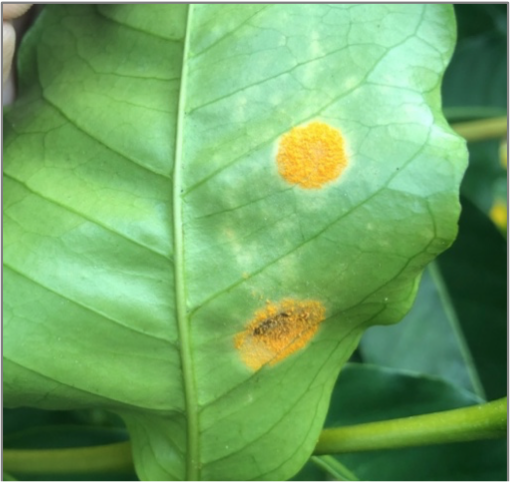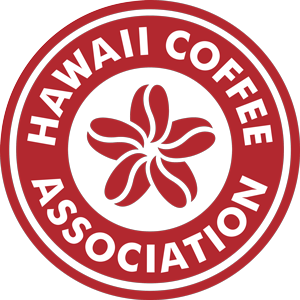PDF Version
Spraying to Suppress Coffee Leaf Rust (Hemileia vastatrix) (Published Nov. 4, 2020)
Coffee Leaf Rust (CLR), Hemileia vastatrix, has been identified in Hawaii. This disease of coffee will cause defoliation, reduced berry size, branch, and tree death. Infections typically start on the lower portion of the tree before reaching the higher leaves. The first symptoms are small, pale yellow spots on the upper surface of leaves (Fig. 1A). On the undersides of leaves, infectious spores appear resembling a patch of yellow- to dark orange-colored powder (Fig. 1B, Fig. 2). These young lesions steadily increase in size with the center of the lesion turning necrotic and brown [1]. Stem and berry infection are rare, but CLR can also affect young seedlings.
Why spray to suppress coffee leaf rust?
Over a three to five-month period, one CLR lesion can produce upwards of 400,000 spores that become airborne and easily spread throughout a farm and between farms. If left untreated, berry production and foliage losses caused by CLR on non-resistant coffee varieties can be significant, ranging between 30% and 80% [4,5]. Yield is completely lost when the tree is killed.
Plant susceptibility to CLR attack increases with berry yield and host density [4]. Field sanitation, proper pruning, fertility, CLR monitoring, and early detection are key for reducing this pathogen threat to tree health and production. When applied properly, and at <5% infection rate of total farm foliage, contact fungicides can be helpful in protecting coffee trees from initial and increased disease severity [10]. While contact fungicides are available for Hawaii coffee producers, currently, there are no approved systemic fungicides for use in Hawaii. Physical removal, containment, and destruction of leaves and branches displaying lesions can help to reduce CLR inoculum and infection [2].
 Figure 1: Coffee leaf rust on the upper leaf surface (A) and lower leaf surface (B) of coffee.
Figure 1: Coffee leaf rust on the upper leaf surface (A) and lower leaf surface (B) of coffee.
Brackets e.g. [2], correspond to literature citations found in the Literature Cited section. This publication is expected to evolve as more is learned about coffee leaf rust in Hawaii.
This document provides suggestions for producers on the use of fungicides for the suppression of CLR on farms and the use of fungicides to reduce establishment severity of the pathogen. Special attention is needed for pesticide resistance management to fungicides with product rotation and proper use. Additional CLR information can be found at www.HawaiiCoffeeEd.com/clr.
Table 1 provides a list of fungicides approved by the Hawaii Department of Agriculture for use on coffee in Hawaii and lists CLR on the label. Although there are other fungicides approved for use in Hawaii, unless coffee is listed on the label, you should not use these products on your coffee crop. Failure to adhere to pesticide regulations could result in legal action and fines by regulatory authorities.
Suggestions for preventative and suppression spray applications
THE LABEL IS THE LAW. READ AND FOLLOW PRODUCT LABELS FOR ALL PESTICIDES.
PRODUCT ROTATION IS HIGHLY RECOMMENDED TO REDUCE THE RISK OF PESTICIDE RESISTANCE BY COFFEE LEAF RUST AND OTHER DISEASES.
Personal protective equipment (PPE):
Follow the label for proper use of PPEs.
Disposable PPEs may be a consideration for use.
Type of sprayer:
-
According to experts at CIRAD, a French agricultural research center, motorized sprayers should not be used for initial CLR treatments to contain spores [3].
o Spores may become airborne and spread if using a high pressure sprayer.
o Reduce sprayer pressure or change the nozzle to create larger droplets as needed.
-
Water quantity per acre will depend on individual spray calibration for your trees and farm. o Calibrate your sprayer by following examples and directions in publications for sprayer calibration [7,8,9].
 Figure 2: Close-up of powder- like coffee leaf rust spores on the underside of a coffee leaf.
Figure 2: Close-up of powder- like coffee leaf rust spores on the underside of a coffee leaf.
Where and what to spray:
-
Spray the entire coffee tree with emphasis on the undersides and topsides of the leaves.
o ACLRsporeproducesgermtubes(germinates)thatentertheplantviathestomata,
which are found on the undersides of leaves [5].
-
Spray all producing, non-producing, and seedling coffee plants.
o Good spray coverage is important.
o A slowed walking pace and deliberate spray application may be necessary to achieve complete coverage of the tree foliage and leaf surfaces.
Consult the label about intentional ground spraying.o Field sanitation and early detection of CLR is important.
o CLR mycelium require a living host tissue or cell to remain alive; however, its urediniospores can survive about six weeks and through dry periods [1].
Reduce the development of pesticide resistance to the products listed in Table 1.o It will be more difficult to control diseases with resistance to approved fungicides. o Alternate and rotate the use of fungicides in different FRAC groups as listed in
Table 1.
§ This typically applies to the use of all pesticides unless noted on the label.
o For example, if you use a blue product like Serenade ASO (FRAC Group 44) for your first application, then use a yellow product such as Kocide 3000 (FRAC Group M1) for your next application. Then, switch back to Serenade or rotate to a pink product (FRAC Group BM 02). Avoid using the same colored product in back-to- back applications.
o If your farm is certified organic, an example for rotation is to use a pink product like DoubleNickel LC, then use a yellow product like Badge X2 next. Then, switch back to DoubleNickel LC or rotate to a blue product. Again, avoid using the same colored product in back-to-back applications.
When to spray:
-
Avoid spraying during rain, drought, and in high heat, if possible.
-
Follow the product label for frequency of application.
Other additions to the fungicide:
Consult with the product label before mixing and combining other products with the fungicide.
o Some pesticide products are not compatible with certain additives such as those noted below.
o If the mixture of products causes phytotoxicity on the coffee trees, stop applications immediately.
Sticker/spreader
o Stickers help the product to adhere to the surface and remain on the plant following application. Spreaders and adjuvants help with dispersal and coverage by reducing water surface tension and allowing the droplets to spread and cover more surface area on leaves, branches, berries, etc.
o A spreader could improve spray coverage.
o If anticipating rain, a sticker and spreader could improve spray adhesion and coverage.
o Review the product label and the BioWorks BotaniGard® compatibility chart.
o https://www.bioworksinc.com/wp-content/uploads/products/shared/botanigard-
tank-mix-compatibility.pdf
o According to the above link, tests were not carried out to evaluate impact on the partner product integrity or for plant phytotoxicity.
Spraying to control anthracnose (Colletotrichum sp.) and cercospora leaf spot and berry blotch (Cercospora coffeicola) [5] on coffee as well as CLR:
-
Spraying to control Colletotrichum sp., another fungal disease on coffee in Hawaii, may require higher rates than necessary for CLR. Consult the product label.
-
Conduct annual or biennial leaf tissue and soil sample tests to determine and prevent plant and soil toxicities when applying copper-based and other products.
Other important considerations:
Re-entry interval (REI) following a spray application.o Follow the required REI, being especially mindful of pickers and when they will
enter the field for harvest.
o Also, follow any restrictions regarding application before crop harvest. This is
typically referred to on the label as the Pre-Harvest Interval or PHI.
o Follow the label rate. Underuse of a product can cause pesticide resistance by the
pest or disease and additional losses if spray applications are ineffective.
o Overuse of a product can cause plant, soil, and environmental toxicities and
hazards, is a violation of product use, and has increased costs to the producer. à Maximum applications per year or season.
o Follow the label instructions.
o Again, overuse of a product can cause plant, soil, and environmental toxicities and
hazards, is a violation of product use, and has increased costs to the producer.
ALWAYS READ AND FOLLOW THE PESTICIDE PRODUCT LABEL DIRECTIONS.
If you have questions, contact your local Cooperative Extension or statewide coffee agent, Andrea Kawabata, at andreak@hawaii.edu. Texts and photos can be sent to (415) 604-1511.
Acknowledgements:
This publication was created by Andrea Kawabata (UH-CTAHR) and reviewed by Dr. Stuart T. Nakamoto (UH-CTAHR), Dr. Lisa Keith (USDA-ARS), and Suzanne Shriner (industry). Much appreciation to the farmers who provided the photos in this publication.
Literature Cited:
-
Arneson, P.A. 2011. “Coffee rust”. The Plant Health Instructor. DOI: 10.1094/PHI-I- 2000-0718-02.
http://www.apsnet.org/edcenter/intropp/lessons/fungi/Basidiomycetes/Pages/CoffeeRust.
aspx
-
Avelino, J., and Savary, S. 2004. Effects of crop management patterns on coffee rust epidemics. Plant Pathology, 53, 541–547. https://bsppjournals.onlinelibrary.wiley.com/doi/full/10.1111/j.1365-3059.2004.01067.x
-
Keith, L. Personal communications. 2 November 2020.
-
Koehler, J. 2018. Coffee rust threatens Latin American crop; 150 years ago, it wiped out
an empire. NPR. https://www.npr.org/sections/thesalt/2018/10/16/649155664/coffee-rust-
threatens-latin-american-crop-150-years-ago-it-wiped-out-an-empire.
-
Kushalappa, A.C. and A.B. Eskes (eds). 1989. Coffee Rust: Epidemiology, Resistance and Management. CRC Press, Boca Raton, Florida. 345 pp.
-
Nelson, S.C. 2008. Cercospora leaf spot and berry blotch of coffee. Honolulu (HI): University of Hawaii. 6p. (Plant Disease Series; PD-41). https://www.ctahr.hawaii.edu/oc/freepubs/pdf/PD-41.pdf.
-
Thap, C. 2010. Using and calibrating backpack sprayers. In: Montana State University’s Big Sky Small Acres Magazine. pp. 10-11. https://apps.msuextension.org/magazine/assets/docs/Using%20and%20Calibrating%20Ba ckpack%20Sprayers.pdf.
8. Uyeda, J., M. Kawate, J. Coughlin, J. Kam, J. Sugano, S. Fukuda, R. Shimabuku, and K.H. Wang. 2015. Sprayer calibration using the 1/128th method for motorized backpack mist sprayer systems. Honolulu (HI): University of Hawaii. 5p. (Pesticide Risk Reduction Education Series; PRRE-9). https://www.ctahr.hawaii.edu/oc/freepubs/pdf/PRRE-9.pdf.
9. Uyeda, J., J. Sugano, S. Fukuda, M. Kawate, R. Shimabuku, and K.H. Wang. 2013. Sprayer calibration using the 1/128th method for handheld spray gun systems. Honolulu (HI): University of Hawaii. 4p. (Pesticide Risk Reduction Education Series; PRRE-7). https://www.ctahr.hawaii.edu/oc/freepubs/pdf/PRRE-7.pdf. Zambolim, L. 2016. Current status and management of coffee leaf rust in Brazil.
10. Trop. plant pathol. 41, 1–8. https://doi.org/10.1007/s40858-016-0065-9.
